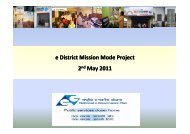State Mission Mode Project e-district - Department of Electronics and ...
State Mission Mode Project e-district - Department of Electronics and ...
State Mission Mode Project e-district - Department of Electronics and ...
You also want an ePaper? Increase the reach of your titles
YUMPU automatically turns print PDFs into web optimized ePapers that Google loves.
Study Report on Assessment <strong>of</strong> the <strong>Mode</strong>l e-<strong>district</strong>s<br />
Empowerment <strong>of</strong> functionaries<br />
There needs to be a provision for empowering local functionaries to be able to delivery services<br />
with speed <strong>and</strong> certainty. While this is possible with some amount <strong>of</strong> st<strong>and</strong>ardization, it would be<br />
necessary to make the data necessary for service delivery very comprehensive <strong>and</strong> reliable. This<br />
single factor alone would enable efficient service delivery by personnel lower down the hierarchy,<br />
while only exceptions can be escalated up the organizational hierarchy. During the project<br />
implementation stage, empowerment <strong>of</strong> functionaries is expected to be conducive to assist in<br />
change management, disseminating information locally <strong>and</strong> providing a system <strong>of</strong> checks <strong>and</strong><br />
balances.<br />
Continuity <strong>of</strong> project team<br />
The team <strong>of</strong> field <strong>of</strong>ficers involved in these projects has been instrumental in conceptualization<br />
<strong>and</strong> implementation under the guidance <strong>of</strong> a project champion. To ensure that there is continuity<br />
<strong>and</strong> sustained activity through the project life-cycle, there should be a m<strong>and</strong>ate to ensure that the<br />
project team remains the same at least for three years, as far as possible.<br />
Focus on service delivery rather than work flow automation<br />
During the assessment phase, several models that were studied have focused on work flow<br />
automation <strong>and</strong> building efficiencies in the working <strong>of</strong> the Government back <strong>of</strong>fice e.g.<br />
Collectorate, rather than on delivering services to the beneficiaries. The scope <strong>of</strong> the project<br />
should be clearly delineated in a manner wherein stress is laid on provisioning <strong>of</strong> services to benefit<br />
the citizens <strong>and</strong> to provide an efficient mechanism for delivery <strong>of</strong> these services. From this<br />
perspective it may be necessary to lay more emphasis on the automation <strong>of</strong> specific application<br />
s<strong>of</strong>tware that is necessary for enabling service delivery. In other words, simple<br />
automation/computerization related to service delivery functions would suffice without going<br />
through the rigors <strong>of</strong> introducing electronic workflows.<br />
Inter-operability<br />
Several processes are hitherto manual, although there have been efforts to introduce automation<br />
at various stages especially at the front-end. It is envisaged that large scale process automation<br />
will be carried out through various Central <strong>and</strong> <strong>State</strong> initiatives. The system should be designed in a<br />
manner that it is interoperable with both existing <strong>and</strong> future applications <strong>of</strong> the line department<br />
where interaction is necessary for service delivery. Since the e District project has been<br />
conceptualized primarily as a service delivery model, DIT should consider integration with the<br />
National Gateway MMP, which is being positioned as st<strong>and</strong>ards based communication window to all<br />
the <strong>State</strong> <strong>and</strong> National Depts.<br />
37




